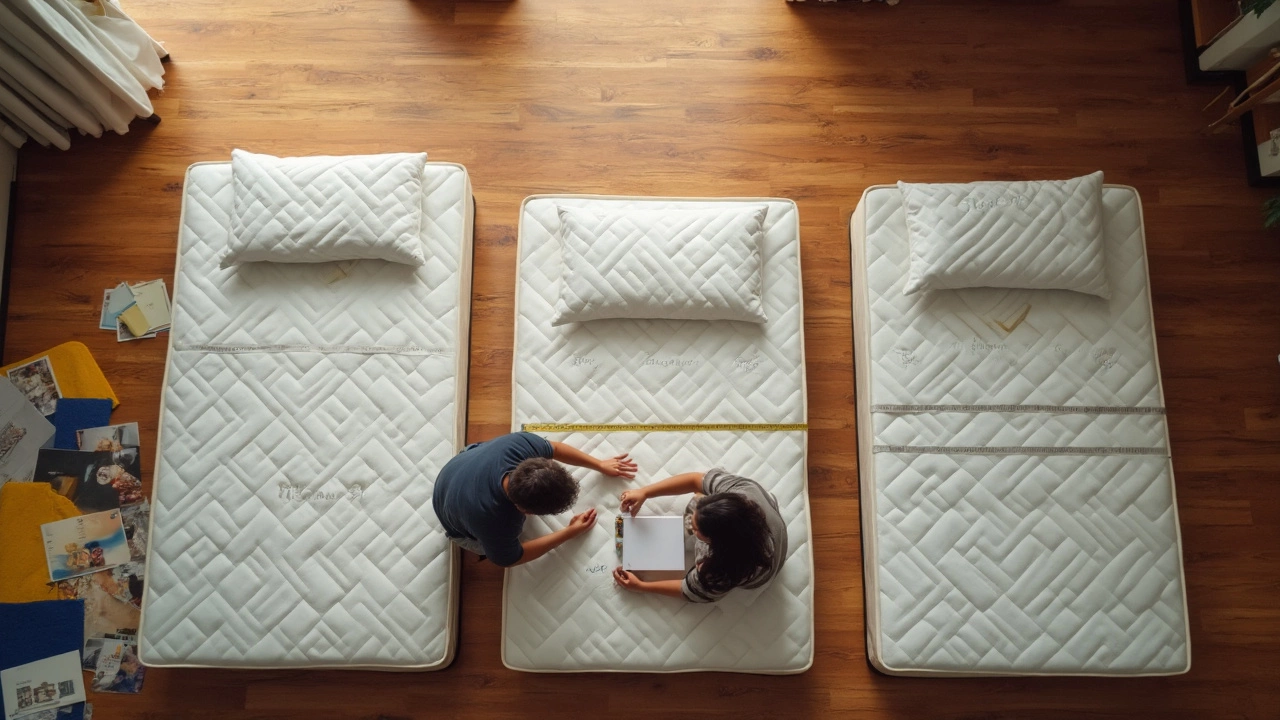Walk into any bedding section and you’ll see Queen size bedding front and center. No surprise there—it's far and away the most popular size in the US. So why do so many people pick Queen? For one, it hits a pretty sweet spot: roomy for couples and cozy for solos who like extra space, but it won’t eat up your whole room like a King does.
The standard Queen mattress measures 60 inches wide by 80 inches long. That's enough elbow room for two average adults without feeling squished, but not so massive that you're stuck with giant fitted sheets that never quite fit. Plus, almost every bedding pattern and style comes in Queen size, so you get more options and usually better pricing.
But, here's where it gets sneaky—mattress thickness keeps creeping up every year, thanks to all those pillow-top and hybrid models. If you’re buying new sheets, always check both the mattress width and the depth. The last thing you want is to wrestle fitted sheets every morning. Let’s break down exactly how bedding size choices can affect your sleep and your home.
- What Bedding Size Tops the List?
- Why Size Matters for Sleep and Space
- Queen vs. King: How the Numbers Stack Up
- Simple Shopping Tips for Bedding That Fits
What Bedding Size Tops the List?
The go-to bedding size in the U.S. is definitely Queen. According to a 2024 industry report from the International Sleep Products Association, around 47% of mattresses sold last year were Queen size. That makes it the clear winner in most American homes, far ahead of King and Full sizes. Queen beds basically hit the middle ground—big enough for couples who want some personal space, but not so bulky that they overtake a regular bedroom.
Why does Queen win? For starters, most adults sleep on Queen beds. It's useful for couples, and even single folks like the extra wiggle room. Plus, apartments, guest rooms, and even teen bedrooms can usually handle a Queen mattress without crowding other furniture. If you look at bedding displays at major retailers—Target, Macy's, or even Costco—you’ll notice Queen sets usually take up the biggest shelf section. Stores love them because people actually buy them the most.
If you’re comparing, here’s where Queen stands next to other standard sizes:
| Size | Dimensions (inches) | Most Common Use |
|---|---|---|
| Twin | 38 x 75 | Kids, small guest rooms |
| Full/Double | 54 x 75 | Teens, singles, small apartments |
| Queen | 60 x 80 | Couples, main bedrooms |
| King | 76 x 80 | Couples who want a lot of space |
| California King | 72 x 84 | Very tall people, large master bedrooms |
The fact is, most popular bed size titles almost always go to Queen, thanks to its balance of size, comfort, and how easy it is to find both mattresses and sheets. If you've got a room that’s at least 10 x 10 feet, you’ll probably be happiest with a Queen setup.
Why Size Matters for Sleep and Space
Picking the right bedding size isn’t just about what looks nice on the sales floor—it shapes how well you actually sleep and how much space you’ve got left to walk around. If your bed’s too small, it can leave you rolling to the edge or fighting for covers with your partner. If it’s too big, you might barely be able to open your closet or fit a nightstand in your room. It’s all about balance.
Here’s something a lot of people don’t realize: the size of your bed affects your actual sleep. The Sleep Foundation says adults need at least 24 inches of personal sleeping space each. That’s why a Queen bed (with 60 inches of width) works so well for most couples. You both get a little stretch room, even if your dog or cat decides to join you in the dead of night.
But let’s talk about the room itself. Common advice is to leave at least 24 to 30 inches of walking space on each side of the bed. That way, you’re not bumping shins when you stumble out of bed in the morning. Here’s a quick table to size things up and see what typically fits:
| Mattress Size | Room Size Needed (Min.) |
|---|---|
| Twin | 7 x 10 ft |
| Full | 10 x 10 ft |
| Queen | 10 x 12 ft |
| King | 12 x 12 ft |
Think about who’s sleeping in the bed, how much space they need, and what’s actually going on in your room. Are you sharing with kids or pets? Do you stash storage bins under the bed? It all adds up.
One last thing: your bedding fit matters, too. Fitted sheets that barely stretch over thick mattresses will pop off in the middle of the night. That’s not just annoying—it wrecks your sleep. So before you buy, jot down your mattress height and double-check those sheet measurements. It’ll save you a lot of hassle and help you get a cozy fit that lasts.

Queen vs. King: How the Numbers Stack Up
Shopping for a new bed? The classic choice usually comes down to Queen versus King, so let's put these two side by side. First off, the size difference is clear: Queen mattresses measure 60 inches wide by 80 inches long, while King mattresses bump it up to 76 inches wide by 80 inches long. So, a King is a whole 16 inches wider—just over a foot of extra room for stretching out or letting the dog pile in.
Here's a quick breakdown to compare:
| Queen | King | |
|---|---|---|
| Width | 60 in | 76 in |
| Length | 80 in | 80 in |
| Surface Area (sq in) | 4,800 | 6,080 |
| Avg. Bedding Cost | Lower | Higher |
| Best for | Couples, singles | Couples, families |
The most popular bedding size is Queen, plain and simple. It fits most bedrooms without hogging every inch of floor space. If you’re living in an apartment or sharing a smaller room with a partner, a Queen just works. Plus, you’ll notice stores stock a bunch more bedding options for Queen than for King, and you’ll pay less for both the bed and every set of sheets.
But maybe you’re the type who loves spreading out, or you share your bed with kids or pets. That’s when a King wins, hands down. Just remember: King bedrooms need more space, not only for the bed but for nightstands and walking room. If you have a master bedroom and hate waking up feeling cramped, the King’s extra width makes a real difference.
Think about your sleep style, your room size, and your budget before you pull out your wallet. There’s no shame in sticking with a Queen—even couples with huge bedrooms often do, just because it’s easier all around. On the other hand, if space isn’t an issue and you’re craving that “hotel bed” feeling, the King might be worth the splurge.
Simple Shopping Tips for Bedding That Fits
Nailing the right bedding size isn’t as simple as grabbing any set marked “Queen” or "King." Here are some key tricks to make sure you actually get bedding sizes that make life easy, not frustrating.
- Measure your mattress—twice. Measure the width, length, and, most importantly, depth. Pillow-top and memory foam beds can run extra deep. Sheet sets list pocket depth, so match your actual mattress thickness to the pocket size. If your mattress is 15 inches thick, don’t settle for 12-inch pockets; it won’t stay put.
- Beware of “Full/Queen” sets. These often feel like a compromise and might not fit either size perfectly. For a queen bed, always look for sets labeled specifically “Queen.”
- Read fiber content and fit details. Cotton breathes better, but polyester blends wrinkle less. Deep-pocket sheets help with today’s thicker mattresses — the most common bed in America is Queen and the average thickness has shot up to nearly 13 inches, according to the Sleep Foundation (2023).
- Try before washing. Fit the most popular bed size sheets on your dry mattress before laundering. It’s much easier to return them unwashed if the fit’s off.
- Check brand sizing charts. Some brands run big, some small. Even "standard" can be off by an inch or two. A quick look at brand charts or reviews can save a headache.
It’s not just the sheets, either. Comforters and duvets marked for a queen bed might look skimpy if you like extra sides. “Sizing up one size for comforters can be a smart move for taller sleepers or anyone who shares their bed with a pet,” says sleep expert Ellen Wermter, NP.
“Bedding that fits right isn’t just about aesthetics. Well-fitted sheets and blankets help regulate temperature and keep sleep uninterrupted,” shares the National Sleep Foundation.
One more thing: keep an eye out for sets that skip the top sheet. That’s not a manufacturing error, it’s a trend. Some younger buyers say they just don’t bother with a top sheet at all, and those sets are usually easier on your wallet, too.
| Depth (inches) | Percentage of Mattresses |
|---|---|
| 8-11 | 23% |
| 12-14 | 59% |
| 15+ | 18% |
So, next time you shop, take a couple of quick measurements, check those package details, and don’t be swayed by flashy packaging. A little planning goes a long way for good sleep—and fewer tug-of-war matches with your fitted sheet at 2 a.m.
